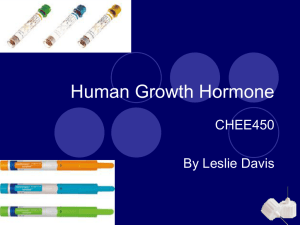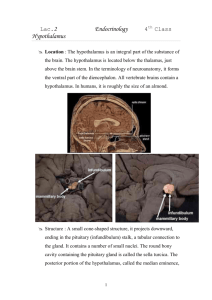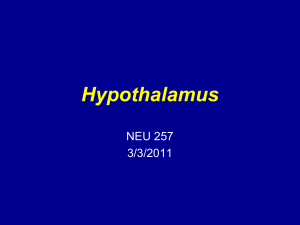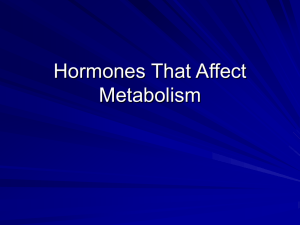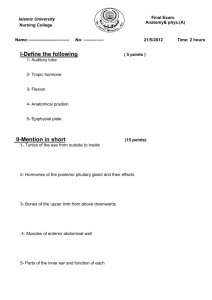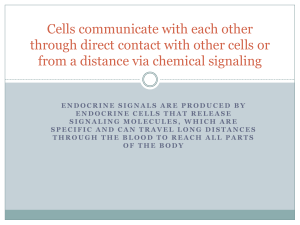Endocrine Hormone Table
advertisement
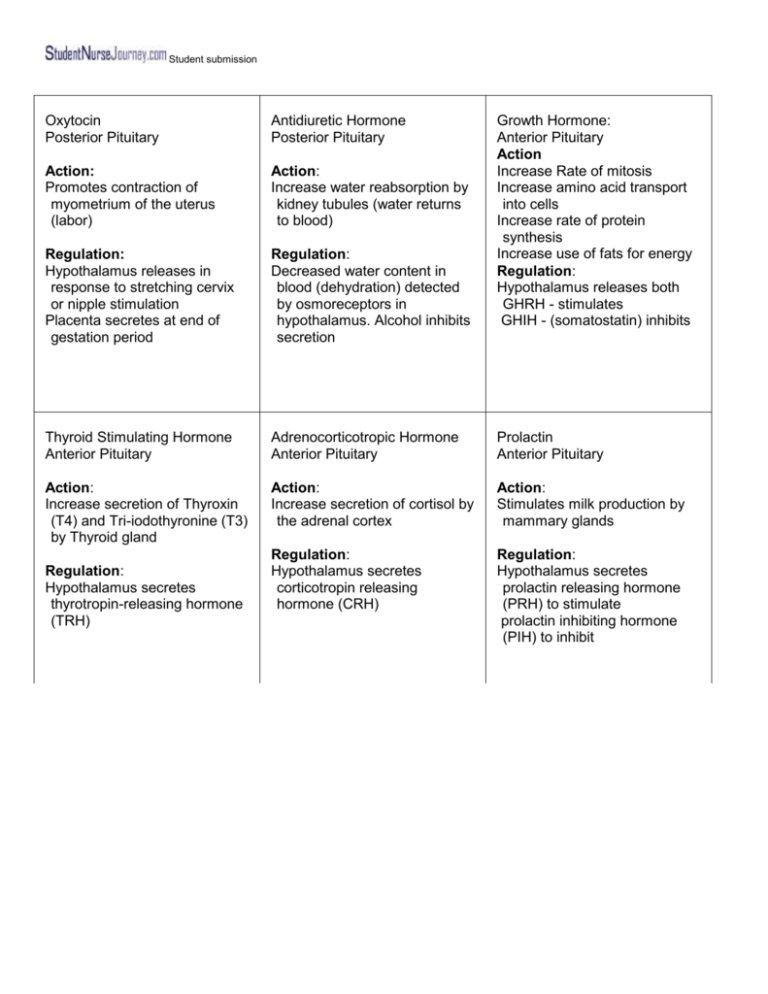
Student submission Oxytocin Posterior Pituitary Antidiuretic Hormone Posterior Pituitary Action: Promotes contraction of myometrium of the uterus (labor) Action: Increase water reabsorption by kidney tubules (water returns to blood) Regulation: Hypothalamus releases in response to stretching cervix or nipple stimulation Placenta secretes at end of gestation period Regulation: Decreased water content in blood (dehydration) detected by osmoreceptors in hypothalamus. Alcohol inhibits secretion Thyroid Stimulating Hormone Anterior Pituitary Adrenocorticotropic Hormone Anterior Pituitary Prolactin Anterior Pituitary Action: Increase secretion of Thyroxin (T4) and Tri-iodothyronine (T3) by Thyroid gland Action: Increase secretion of cortisol by the adrenal cortex Action: Stimulates milk production by mammary glands Regulation: Hypothalamus secretes corticotropin releasing hormone (CRH) Regulation: Hypothalamus secretes prolactin releasing hormone (PRH) to stimulate prolactin inhibiting hormone (PIH) to inhibit Regulation: Hypothalamus secretes thyrotropin-releasing hormone (TRH) Growth Hormone: Anterior Pituitary Action Increase Rate of mitosis Increase amino acid transport into cells Increase rate of protein synthesis Increase use of fats for energy Regulation: Hypothalamus releases both GHRH - stimulates GHIH - (somatostatin) inhibits Student submission Follicle Stimulating Hormone Anterior Pituitary Action: Women - starts growth of ova in ovarian follicle; Increases secretion of estrogen by follicle cells Men - initiates sperm production in seminiferous tubules of testes Regulation: hypothalamus gonadotropin releasing hormone (GnRH) - stimulates GnIH - inhibits Luteinizing Hormone Anterior Pituitary Action: Women: Causes ovulation, Ruptured ovarian follicle becomes corpus luteum and secretes progesterone Men: Increase secretion of testosterone by interstitial cells of testes Regulation: Hypothalamus - GnRH stimulates Melanocyte-Stimulating Hormone Anterior Pituitary Action: Stimulates production of melanin by melanocytes MSH circulating in brain may also stimulate arousal and appetite (Wikki) Regulation: Hypothalamus - corticotropin releasing hormone (CRH) Student submission Thyroxin (T4) Tri-iodothyrinine (T3) Thyroid Gland Action: Increase energy production from all food types (metabolic rate) Increase rate of protein synthesis in cells Calcitonin Thyroid Gland Action: Decrease reabsorption of calcium & phosphate from bone to blood (opposite of Parathyroid hormone) Regulation: Hypercalcemia Parathyroid Hormone Parathyroid Gland Action: Increase reabsorption of calcium (CA) & phosphate (PO4) from bone Increase absorption of calcium & phosphate from small intestine Increase absorption of calcium & excretion phosphate from kidneys Regulation: Hypocalcaemia Regulation: Thyroid stimulating hormone (TSH) Glucagon Pancreas islets alpha cells Insulin Pancreas islets beta cells Somatostatin (GHIH) Pancreas islets delta cells Action: Increase conversion of glycogen to glucose in liver Increase use of excess amino acids and fats for energy (opposite of insulin) Action: Increase ? glucose transport into cell & glucose for energy use in the cell Increase conversion of glucose to glycogen Increase amino and fatty acid transport into and use for synthesis reactions in cells Action: Inhibits insulin, Glucagon, and growth hormone production Regulation: Hypoglycemia Regulation: Increased levels Regulation: Hyperglycemia Norepinephrine Adrenal Cortex Action: Vasoconstriction in skin, viscera, and skeletal muscles Regulation: Sympathetic impulse from the hypothalamus in stress situation Epinephrine Adrenal Cortex Action: ? heart rate & contractions force , dilates bronchioles, ? peristalsis, ? conversion of glycogen to glucose, causes vasodilatation in skeletal muscles & vasoconstriction in skin & viscera, ? fats for energy & cell respiration Regulation: Sympathetic impulse from the hypothalmus in stress situation Aldosterone Adrenal Cortex Action: 1) ? reabsorption of Na+ by kidneys to the blood 2) ? excretion of K+ by kidneys Regulation: 1) Low Blood Na+ level Low Blood volume Low Blood pressure 2) High K+ level Student submission Student submission Cortisol Adrenal Cortex Androgens & Estrogens Adrenal Cortex Action: Action: May cause growth spurt at puberty May contribute to libido Source of sex hormone for women after menopause ? use of fats and excess amino acids for energy , ? Glucose for energy (sparing glucose for brain use) ? conversion of glucose to glycogen in liver Anti-inflammatory effect: stabilizes lysosomes and blocks histamine Regulation: ACTH from pituitary Regulation: ACTH anterior pituitary during psychological stress Thyroid Test TSH 0.5 - 5.0 U/ml ? hypothyroidism ? hyperthyroidism T3 75-195 ng/100ml ? hypothyroidism ? hyperthyroidism T4 4-12 mcg/100ml ? hypothyroidism ? hyperthyroidism Parathyroid Test Parathyroid Hormone <25pg/ml ? hyperparathyroidism ? hypoparathyroidism & trauma Calcium 8.5-10.5/100ml ? cancer & hyperparathyroidism ? hypoparathyroidism Phosphorus 2.4-4.7mg/100ml ?hypoparathyroidism ? hyperparathyroidism Student submission Student submission Pituitary Test Growth Hormone <5ng/ml ? acromegly ? small stature Antidiuretic Hormone 2.3 - 3.1pg/ml ? SIADH ? Diabetes insipidus Urine specific gravity 1.010 - 1.025 ? Diabetes insipidus Adrenocorticotropic <120pg/ml @6-8AM ? Addison’s disease ? Cushing’s Synd ? Longterm corticosteroid therapy Adrenal Test Cortisol 5-25mcg ? Cushing’s Synd & Stress ? Addison’s disease & steroid withdr Vanillylmandelic Acid VMA urine test 0.7 - 6.8 mg ? pheochromocytoma in 24 hours Pancreas Test Fasting Blood Sugar (FBS) 70-110 mg/100ml ? Diabetes M., stress & cushing syndr ? Hypoglycemina &Addison’s Oral glucose tolerance Blood glucose returns to normal within 2 hrs Any 2 values > 140 = diabetes mellitus

